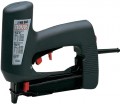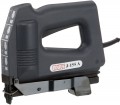Fuse
A device that protects the tool from being triggered at the wrong time.
Most often in a modern tool there are manual fuses in the form of a button or switch. Such a device blocks the release button or opens the power circuit; thus, when the
fuse is on, the tool will not work, no matter what the user does. This reduces the chance of fasteners "shooting" in the wrong direction and reduces the risk of personal injury and property damage.
Min. staple width
The smallest staple width that the stapler can handle.
The width of the bracket is, roughly speaking, the distance between its legs. Different situations and types of work require different sizes of staples, sometimes quite small. At the same time, staples that are too small will hang out in the store and will not be able to properly fit under the drummer, which is why modern staplers have a minimum size limit. You should pay special attention to it if you plan to work with brackets of small width.
Max. staple length
The largest length of staples (see Fastener Type) that the stapler can work with.
The length in this case means the length of the leg — in other words, the depth to which the staple clogged "to the stop" penetrates into the material. This means that working with staples of great length requires not only the appropriate design of the magazine and the feed mechanism — the stapler must also be quite powerful in order to provide the effort necessary for effective clogging. And this, in turn, affects the dimensions, weight and price of the tool. In fact, this means that it does not always make sense to specifically look for a model that can work with long staples — you need to evaluate the specifics of the intended work: often the best choice is a relatively “short”, but at the same time inexpensive and compact tool.
In general, a limit of 10 – 15 mm is typical for entry-level staplers, and in professional models this parameter can exceed 50 mm.
Min. nail length
The shortest length of nails (see Fastener Type) that the stapler can handle.
The shorter the fastener, with the same thickness, the less effort is required to drive it, but a nail that is too short simply cannot stand under impact normally. Therefore, for many instruments, this restriction is directly indicated. It is worth paying attention to it first of all if you plan to work with small short nails.
Functions
—
Adjustment of impact force / depth. The ability to adjust the force of impact or the depth of clogging fasteners. These functions are implemented somewhat differently: the impact force is changed by adjusting the power supplied to the striker upon impact, and the driving depth can be set due to a mechanical limiter — for example, by retracting the striker a certain distance back, so that it simply does not was able to move beyond a certain distance. However, the purpose and use of these functions is similar: first of all, they allow you to change the depth to which the fastener is driven into the material. In addition, adjusting the force of impact (namely force) can be useful when working with delicate materials, where too powerful impacts are undesirable. Specific details of the implementation of this function should be clarified in each case separately.
—
Double hit. Possibility of operation of the stapler in the double impact mode. Here, this term means the ability to drive two fasteners at once in one blow — for example, for connections that require increased reliability. Note that double impact most often only works on staples, even if the tool is able to work with other types of fasteners (see above). Firstly, it is for brackets that this possibility is most relevant; secondly, it is much more difficult to implement it for nails or pins.
—
Bending the staple.... The ability of the stapler to work not only for driving staples, but also for bending their legs after installation. The need for bending arises in cases where the tool is used to fasten relatively thin layers of material, and the staples pierce the parts to be fastened through: bent legs provide a secure hold, and are also safer — the risk of scratching or pricking the protruding edge of the staple is minimal. Note that such work requires an anvil of hard material placed under the fastened materials; in some tools with a bending function, the anvil is part of the design, but most often it is not.
— Blade of knife. The presence of a knife blade in the design of the stapler. This feature allows you to use the tool not only for driving fasteners, but also for cutting material — for example, preparing upholstery for furniture. The blades are usually made removable (so that a dull one can be quickly replaced with a fresh one or sharpened with convenience) and have a beveled shape (this allows you to cut with the very tip of the knife, providing high accuracy and accuracy). However, this function is quite specific, therefore it is rare, and mainly among percussion models (see "Type") — only they turn out to be quite light, compact and convenient for use as knives.
— Backlight. The presence in the stapler of its own built-in flashlight, usually directed in such a way as to highlight the place of impact. This feature is extremely useful when working in low light conditions. Note that such conditions can easily arise even under normal ambient lighting: for example, the tool itself often obscures the impact site, worsening visibility and complicating accurate aiming.
— Brushless motor. Such motors do not have the classic carbon brushes found in conventional power tools, whose friction during engine operation leads to additional heating, which leads to unnecessary energy consumption and general engine wear. Refusal to use them allows you to extend the battery life of the tool, on the one hand, as well as the life of the engine, on the other.Case (bag)
The presence of a case or bag in the tool kit.
Such accessories are more convenient than impromptu packaging, they greatly simplify the storage and transportation of both the tool itself and accessories / consumables. At the same time, cases are the most popular in construction staplers — characteristic suitcases made of solid material. Such a suitcase perfectly protects the instrument not only from moisture and dirt, but also from shocks and shocks; it is also often used as the factory packaging in which the tool goes on sale. Bags made of soft material, in turn, are less common: they do not provide such protection against impacts, and they do not resist water / dust as effectively. On the other hand, such packaging itself is less bulky, and when the bag is not needed, it can be rolled up quite compactly.

